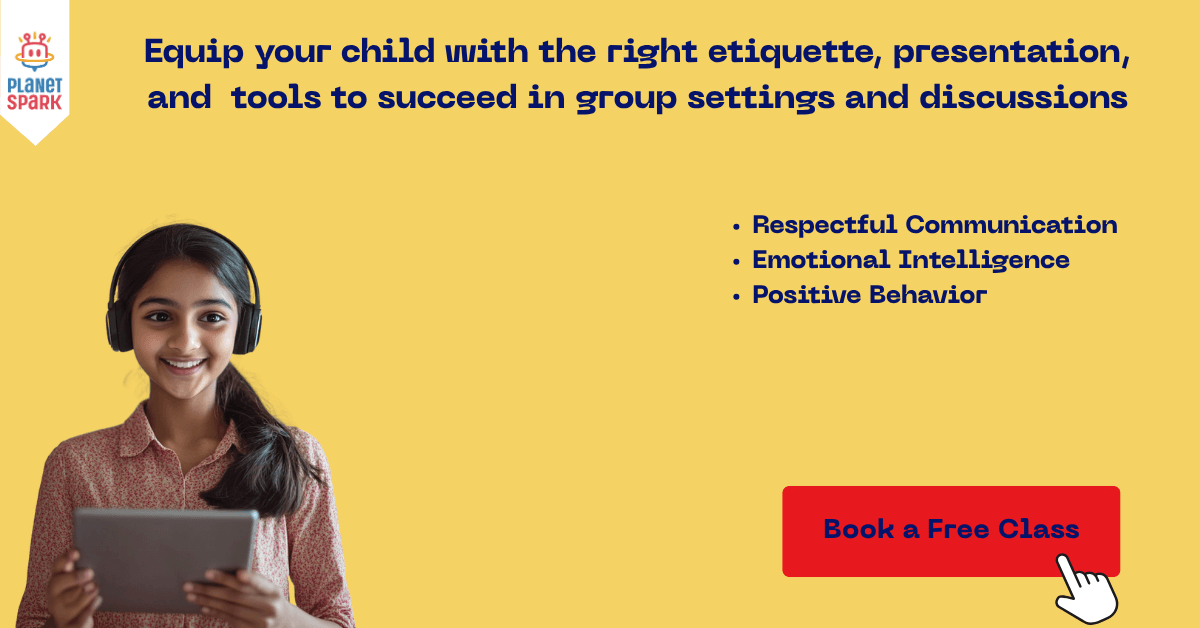Essential Guide to Good Manners at School for Children

Table of Contents
- What Are Good Manners?
- Good Manners at School
- Why Are Good Manners Important at School?
- 15 Examples of Good Manners for Students
- How to Teach Good Manners at School
- Activities to Practice Good Manners
- Challenges in Teaching Good Manners and Solutions
- The Role of Parents in Reinforcing Good Manners
- How PlanetSpark Teaches and Reinforces Good Manners at Schoo
- Conclusion
- FAQs on Good Manners at School
Good manners at school are the foundation of respectful behavior, effective communication, and a healthy learning environment. They’re not just about being polite but about forming meaningful relationships, reducing conflicts, and building a positive school culture. From saying "please" to waiting for one’s turn, good manners help children become socially responsible individuals.
This blog explores everything you need to know about good manners at school, how they shape student success, and how PlanetSpark helps children practice them in everyday communication.
What Are Good Manners?
Good manners are polite, respectful behaviors that show consideration for others. These include verbal cues like "thank you" and "sorry," actions like holding the door for someone, and habits like listening attentively or waiting in line.
At school, good manners are context-specific. They apply to classroom etiquette, interactions with peers and teachers, and general school conduct. Practicing them daily ensures smoother communication and deeper relationships among students and between students and teachers.
Good Manners at School
Good manners at school are actions and behaviors that promote respect, cooperation, and kindness in a classroom or school environment. These behaviors are essential for creating a peaceful, inclusive space where learning thrives.
Core Examples of Good Manners at School
- Greeting and Respect: Saying “Good morning,” “Please,” and “Thank you” when interacting with teachers and peers.
- Listening Actively: Paying attention when someone is speaking and not interrupting.
- Helping Others: Offering assistance to classmates or school staff when needed.
- Using Polite Language: Avoiding rude, hurtful, or inappropriate language.
- Being Punctual: Arriving on time to school and submitting assignments promptly.
- Taking Responsibility: Owning up to mistakes and making an effort to correct them.
- Keeping the Environment Clean: Disposing of waste properly and keeping desks tidy.
- Respecting Property: Taking care of school supplies, classroom furniture, and others' belongings.
Benefits of Teaching Good Manners in School
- Improved Academic Outcomes: Respectful behavior helps maintain focus and reduces classroom disruptions.
- Enhanced Social Skills: Children learn how to collaborate, compromise, and handle conflicts peacefully.
- Positive School Culture: A polite and respectful school environment fosters inclusivity and safety.
- Emotional Growth: Good manners instill empathy and self-regulation.

How Parents and Teachers Can Reinforce Manners
- Modeling Behavior: Adults should demonstrate the same manners they expect from children.
- Role-Playing Scenarios: Engage children in real-life situations where they practice polite interactions.
- Recognition and Praise: Acknowledge when children behave well to reinforce positive behavior.
- Routine Reinforcement: Make good manners a consistent part of daily school and home routines.
- Manners Charts and Games: Use visual reminders and gamified tasks to make learning fun.
Good Manners at School: Building a Culture of Respect
Schools that integrate good manners into their culture benefit from:
- Fewer disciplinary issues
- Better student engagement
- Enhanced school reputation
- Stronger teacher-student bonds
Examples of how schools can promote manners:
- Morning assembly sessions focusing on value education
- Celebrating ‘Manners Week’ or ‘Respect Day’
- Installing reminder posters across the campus
- Incorporating manners into school rules and codes of conduct
Teaching Digital Manners in School
With online classes and digital learning becoming common, teaching good digital etiquette is vital:
- Muting microphones when not speaking
- Using appropriate chat messages
- Respecting others' opinions in virtual discussions
- Avoiding distractions during online classes
Help your child master good manners at school with PlanetSpark’s expert-led sessions. Enroll now and claim your free trial class today!
Why Are Good Manners Important at School?
1. Promotes Mutual Respect
When students speak politely and behave respectfully, they build positive relationships with peers and teachers.
2. Improves Learning Environment
A polite classroom is a productive one. With fewer disruptions, teachers can focus on instruction, and students can concentrate on learning.
3. Encourages Empathy and Kindness
Good manners help children understand and care for others. It encourages listening, compassion, and cooperation.
4. Reduces Conflicts
Polite behavior minimizes misunderstandings and disputes. Children learn to solve issues calmly and respectfully.
5. Builds Strong Character
Respectful behavior nurtures emotional intelligence and social maturity, which are crucial life skills.
15 Examples of Good Manners for Students
Here are specific, practical examples of good manners every student should practice:
- Greet teachers and classmates with a smile
- Saying "excuse me" before interrupting
- Waiting quietly for your turn
- Listening without talking over others
- Keeping your workspace clean
- Respecting classroom rules
- Sharing classroom materials
- Helping new students settle in
- Saying "sorry" when wrong
- Avoiding gossip and hurtful language
- Respecting school property
- Showing appreciation with words
- Responding to instructions promptly
- Holding the door for others
- Using polite tones and expressions
Each of these examples reinforces cooperation, consideration, and responsibility.
How to Teach Good Manners at School
1. Role Modeling by Teachers
Children observe and mimic adult behavior. Teachers who consistently use respectful language and actions set the standard.
2. Use Stories and Role-Playing
Interactive storytelling and acting out scenarios can demonstrate correct and incorrect behaviors in fun, memorable ways.
3. Reinforce Positive Behavior
Praise and recognition, whether through classroom rewards or verbal appreciation, motivate children to repeat good behavior.
4. Establish Clear Expectations
Teachers should explicitly state behavioral expectations and display them in classrooms.
5. Use Visual Aids and Charts
Manners charts help children track and reflect on their behavior. It turns learning into a visual, daily habit.
6. Create a Manners Corner
A dedicated classroom corner for quotes, videos, and role-play activities around manners keeps the focus alive and engaging.
Empower your child with essential life skills like good manners at school through PlanetSpark’s engaging classes. Start with a free class today!
Activities to Practice Good Manners
Engaging children with activities makes manners easy to grasp and fun to apply:
- Manners Charades: Act out polite behaviors for classmates to guess.
- Compliment Chain: Every child gives and receives a compliment.
- Good Deed Journal: Students write down one kind act they did each day.
- Manners Bingo: Check off positive behaviors seen throughout the week.
- Story Time with a Lesson: Discuss stories that include moral lessons.
Challenges in Teaching Good Manners and Solutions
Challenge 1: Lack of Consistent Reinforcement
If manners are taught at school but ignored at home, children may become confused. Solution: Involve parents through regular communication and activities that can be extended at home.
Challenge 2: Behavioral or Emotional Issues
Some children might struggle with impulse control or social understanding. Solution: Work with counselors and use behavioral support strategies.
Challenge 3: Cultural Variations
What’s considered polite in one culture may differ in another. Solution: Create a respectful environment that embraces diversity and educates students about differences.

Common Challenges and Solutions
| Challenge | Solution |
|---|---|
| Inconsistent reinforcement | Develop a school-wide behavior policy |
| Peer influence | Conduct peer-led workshops |
| Lack of role models at home | Introduce mentorship programs |
| Disruptive classroom habits | Practice mindfulness and SEL sessions |
The Role of Parents in Reinforcing Good Manners
- Model Manners at Home: Children are quick to imitate adult behavior.
- Talk About School Experiences: Daily discussions help connect lessons with real-world situations.
- Set Rules with Explanations: Don’t just tell them what to do, explain why it matters.
- Praise Respectful Actions: Verbal encouragement boosts morale and consistency.
- Use Stories and Cartoons: Children remember lessons better through visual content.
PlanetSpark and Good Manners at School
PlanetSpark integrates behavioral training into its curriculum by focusing on communication, emotional intelligence, and respect. Our trained educators incorporate practical exercises, real-life scenarios, and personalized feedback to help students consistently display good manners at school.
Through engaging online sessions and a behavior-first approach, we ensure students develop:
- Respectful speech habits
- Confidence in group settings
- Active listening and empathy
Want your child to stand out for their behavior and personality? Join PlanetSpark’s personality development programs today.
Boost your child’s social confidence and discipline with PlanetSpark’s good manners at school module. Sign up for a free trial session.
How PlanetSpark Teaches and Reinforces Good Manners at School
At PlanetSpark, our communication programs don’t just focus on grammar or vocabulary, they foster respectful, expressive, and well-mannered communicators. Here’s how:
1:1 Personal Trainers for Every Child
Each student is matched with a certified communication expert who:
- Tailor sessions to your child's learning pace and style
- Offers immediate, constructive feedback
- Builds fluency, storytelling, grammar, writing, and manners through live interactions
Personalised Curriculum & Learning Roadmap
Our unique roadmap:
- Begins with a detailed skill assessment
- Targets gaps in fluency, vocabulary, and confidence
- Evolves based on the child’s progress and behavior
SparkX – AI-Enabled Video Feedback
With SparkX, your child can:
- Upload practice videos
- Receive AI-powered analysis on tone, posture, grammar, and clarity
- Improve polite speaking, respectful responses, and structured conversation
AI-Led Speaking Practice
Students interact with an AI coach to:
- Practice speech and storytelling
- Receive real-time feedback
- Refine grammar, manners, and articulation
Spark Diary
Encourages:
- Daily journaling
- Polite expression through writing
- Habit formation for thoughtful communication
Gamified Learning
Fun activities like:
- Grammar Guru Challenge
- Word Wisdom & Spell Knockout
- Manners-based quizzes and vocabulary games
Structured Parent-Teacher Meetings
- Regular PTMs
- Progress sharing on manners, confidence, and speech
- Personalized home support plans
Comprehensive Progress Reports
Detailed insights on:
- Fluency and grammar
- Respectful speaking
- Confidence and emotional maturity
Exclusive Learning Clubs
- Debate Club and Story Writing Club
- Speech, Poetry, Comedy, and Podcast Circles
- Peer-to-peer respect and performance experience
Sparkline: Safe Sharing Platform
Children safely post speeches, stories, and videos and receive peer encouragement, boosting polite expression and digital etiquette.
Contests and Showcases
Regular storytelling, speech, and writing contests celebrate respect, manners, and creativity.
SparkBee & SparkShop
- SparkBee: Fun quizzes for grammar, spelling, manners
- SparkShop: eBooks that blend English and values-based learning
At PlanetSpark, good manners at school are woven into every learning module, speech practice, and writing task. Because we believe confident children should also be kind, empathetic, and respectful communicators.
Conclusion
Teaching good manners at school is about much more than following rules. It’s about shaping future-ready, respectful, and emotionally intelligent individuals. Parents and teachers must work together to consistently model and reinforce good behavior.
With PlanetSpark’s well-rounded programs, your child not only learns to speak well but also learns to speak kindly, developing social grace, empathy, and strong communication skills that last a lifetime.
FAQs on Good Manners at School
Q1. What are the top 5 good manners students should follow in school?
Listening when others are speaking, respecting teachers, saying polite words, being punctual, and helping classmates.
Q2. How do good manners help in school life?
They foster a respectful and collaborative environment, reduce conflicts, and enhance learning outcomes.
Q3. At what age should children start learning good manners?
As early as 2 to 3 years. However, reinforcement should continue throughout school.
Q4. How can teachers promote good manners in class?
Through modeling, setting expectations, storytelling, and consistent reinforcement.
Q5. Are good manners part of emotional intelligence?
Yes, they involve empathy, self-awareness, and social sensitivity.
Q6. Can online classes help teach manners to children?
Absolutely. PlanetSpark’s live, guided learning sessions embed etiquette in speaking and writing practice.
Q7. What’s the difference between good manners and discipline?
Good manners relate to kindness and respect. Discipline involves following rules. Both work together to develop character.
Personalized Communication Report
Record a video to get a AI generated personalized communication report for your child

Hi There, want to try these
tips for your child with
LIVE with our expert coach?
Let's check your child's
English fluency
